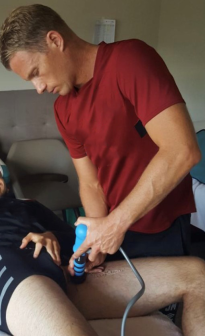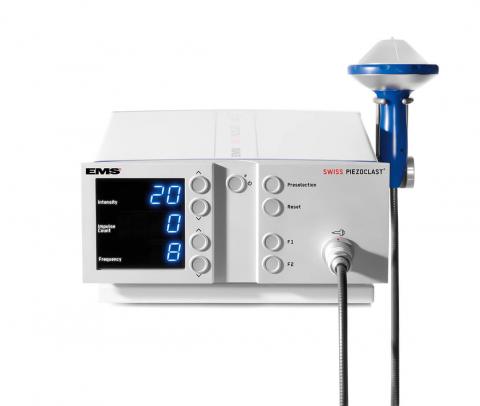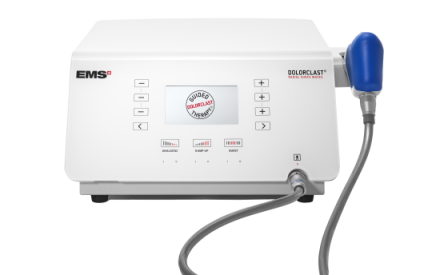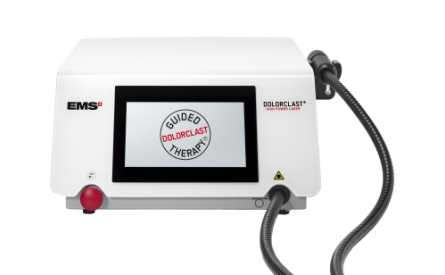
Treatment of Quadricep Tendon tendonosis with associated calcification
Step 1 - Anamnesis
Objective examination
Functional movement examination such as knee flexion in a standing position on one leg was enough to reproduce pain. One-legged hopping was possible but reproduced significant pain. The passive range of movement was full, but pain provocation was significant in end-of-range knee flexion. Resisted knee extension was painful. There was considerable soreness upon palpation over the quadriceps tendon attachment onto the patella. Ultrasound sonography examination revealed a significant extent of calcification and degenerative changes within the quadriceps tendon.

Step 2 to 5 - Treatment
Treatment approach:
It was decided to use the Guided DolorClast® Therapy with a combination of laser and extracorporeal shock wave treatments, as well as specific (initially) isometric strength exercises and cryotherapy. The attempt was to keep the player available for regular training and match play throughout the entire treatment period. This protocol involved regular treatment over 12 weeks utilising the EMS DolorClast® High Power Laser in combination with the EMS Dolorclast® Radial Shock Wave and the EMS Piezoclast® focused shock wave therapy machines.

Weeks 1-4
3-4 x weekly EMS Swiss Dolorclast® 9000 Impulses/2.5-3.0 Bar/Frequency 25
Hz/16mm applicator over the quadricep tendon attachment. These settings were chosen based on experience:
- Treatments at high frequencies, 21 - 25 Hz, have had great results, reduced treatment time, and may be perceived as more comfortable by the patient.
- The number of impulses is due to the close relationship between player and therapist and the experience of how the patient reacts to the treatment. Generally, it is advisable to choose a lower number, e.g., half the number of impulses, and evaluate the reaction to treatment. After 1-2 treatment sessions, the number of impulses or the amount of energy can be increased.
In addition, daily isometric leg extension exercises directly prior to training 5 x 45 second holds with the maximum possible weight. Following training, cryotherapy for 30 minutes was applied.

After this initial treatment period, the pain level in everyday life after training sessions remained high: 8/10 VAS. Despite the high amount of energy delivered to the patient, an improvement while keeping the player in practice and match play has not been achieved.

Weeks 5-8
Because of the continued high pain level, it was hypothesized that more energy delivery was needed. Therefore, a combination of laser and shock wave therapy was chosen to maximize energy delivery:
3 x weekly EMS High Power Laser „Analgesic“ Programme applied for 9 minutes directly over the quadriceps tendon attachment, followed by EMS Piezoclast® focused shock wave therapy 4000 Impulses/Intensity 8-12/8 Hz/15mm gel pad applicator. In addition, daily isometric leg extension exercises directly prior to training 5 x 60 second holds with the maximum possible weight. Following training, isotonic quadriceps exercises and cryotherapy for 30-60 minutes were performed.
After this second treatment period, the pain level in everyday life after training sessions dropped significantly: 2/10 VAS.
Weeks 9-12
2 x weekly EMS High Power Laser „Analgesic“ Programme applied for 9 minutes directly over the quadriceps tendon attachment, followed by EMS Piezoclast® focused shock wave therapy 4000 impulses/intensity 12-15 / 8 Hz/15mm gel pad applicator. In addition, daily isometric leg extension exercises directly prior to training 5 x 60 second holds with the maximum possible weight. Following training isotonic and eccentric quadricep exercises and cryotherapy for 30-60 minutes.
After this last treatment period, the pain in everyday life disappeared: 0/10 VAS.

Summary
The player reported a significant reduction in pain during and after training and matches, especially during weeks 5-8, where the therapy was combined in adherence with the Guided DolorClast® Therapy protocol. As a result, it was possible to keep the player fully involved in training and to reduce the sharp increase in pain that was reported to affect the player’s quality of life following training sessions to the extent that it was no longer noticeable during activities of daily living. The pain reduction achieved via regular, systematic application of high power laser and shock wave therapy also enabled a progression of strengthening exercises for the quadriceps muscle group to take place: isometric --> isotonic --> eccentric. This helped to increase the player's pain-free function during training and playing professional football

James Morgan
MSc. BHSc.(Physio) BSpLS
Head of Rehabilitation, Physiotherapy & Prevention
Sankt Pauli FC
Bundesliga 2, Germany


